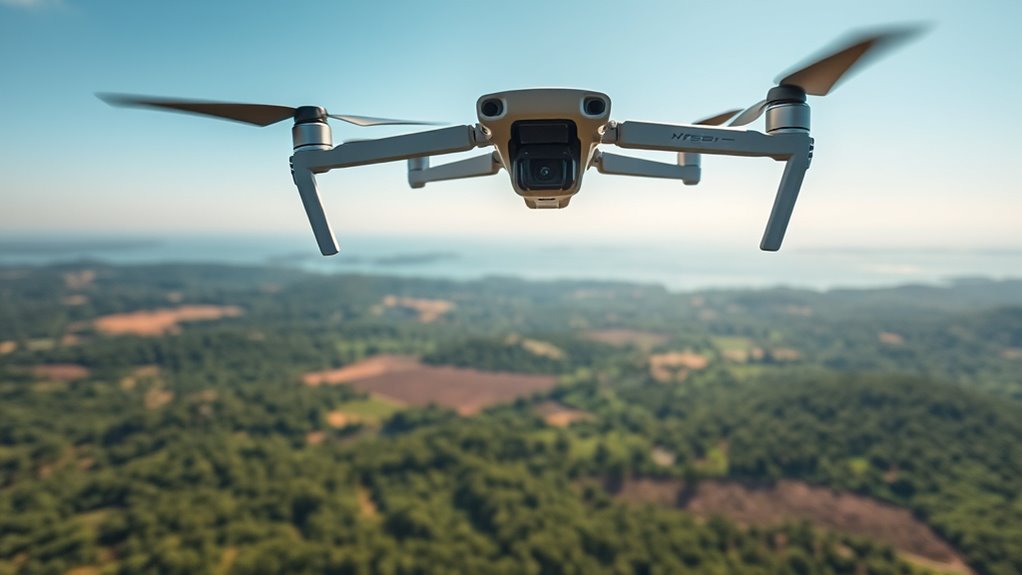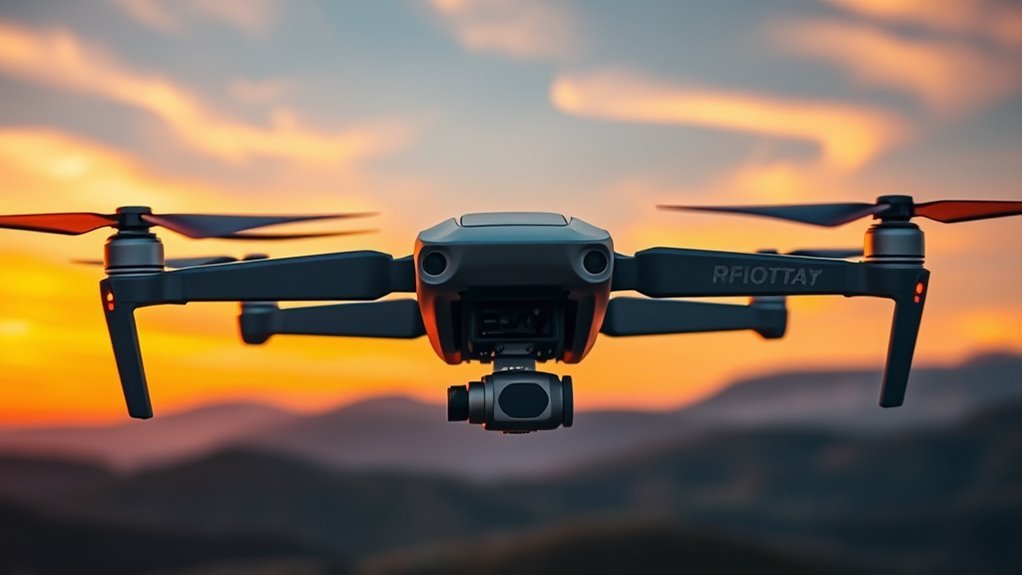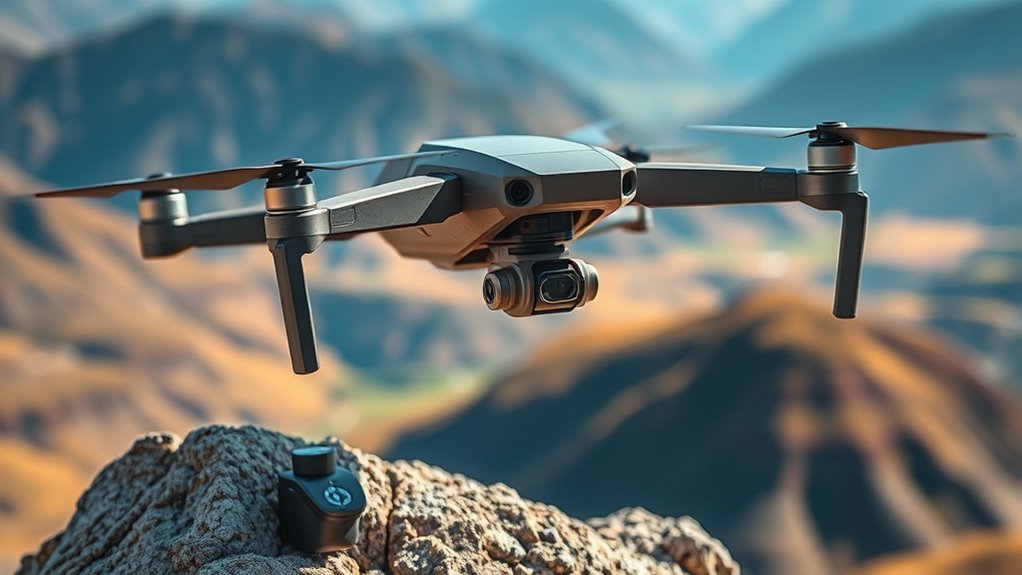A gimbal is a pivoted support that stabilizes your drone’s camera by counteracting vibrations and movements along pitch, roll, and yaw axes. You’ll commonly find 1-, 2-, or 3-axis gimbals, each offering varying stabilization degrees for smooth footage. Key components include brushless motors and stabilization algorithms that react instantly to drone motion. Proper calibration and correct damping settings are essential for peak performance. Understanding these basics sets the groundwork to master advanced stabilization techniques and elevate your aerial videography.
What Is a Gimbal and How Does It Work?

A gimbal is a pivoted support mechanism that allows an object, such as a camera on a drone, to rotate smoothly along one or more axes. When you use gimbal technology, you gain precise control over the orientation of your camera despite the drone’s movement. This stabilization is vital for capturing steady images and video, as it counteracts vibrations, tilts, and sudden shifts. The gimbal’s motors and sensors detect motion and instantly adjust the camera’s angle to maintain a fixed horizon or subject focus. By integrating this system, drone stabilization becomes seamless, granting you the freedom to maneuver your drone aggressively or in challenging conditions without sacrificing footage quality. Fundamentally, the gimbal isolates the camera from drone movements, delivering fluid, professional-level shots every time.
Types of Gimbals Used in Drones

Understanding how gimbals stabilize your drone’s camera sets the stage for recognizing the differences in their designs. You’ll encounter several gimbal types tailored to various drone applications, each offering unique stabilization benefits.
Grasping gimbal stabilization is key to appreciating the various designs and their unique benefits for drones.
- 1-Axis Gimbals: These control tilt, suitable for simple applications where vertical motion correction suffices but limit smooth freedom.
- 2-Axis Gimbals: Managing tilt and roll, these provide enhanced stability, ideal for drones capturing dynamic movements without full rotational freedom.
- 3-Axis Gimbals: The most advanced, controlling tilt, roll, and pan, allowing complete freedom of movement and precision, essential for professional aerial cinematography.
Key Components of a Drone Gimbal

Although gimbals vary in complexity, you’ll find their core components consistently work together to maintain camera stability. Central to this system are the gimbal motors—brushless and precisely controlled—that actively counteract drone movement across three axes: pitch, roll, and yaw. These motors respond instantly to input, adjusting the camera’s position to keep footage smooth. Complementing this hardware are stabilization algorithms running on the gimbal’s controller, which interpret sensor data to predict and correct unwanted motion. Together, these components create a dynamic balance, ensuring your camera remains steady despite drone vibrations or sudden movements. Understanding how gimbal motors and stabilization algorithms interact empowers you to appreciate the technology that grants your drone’s camera unparalleled freedom and stability in flight.
How to Calibrate Your Drone’s Gimbal
Before starting calibration, verify your drone is on a level surface and the gimbal is free of obstructions. You’ll follow specific steps to reset and align the gimbal’s sensors for peak stability. If you encounter errors, troubleshooting usually involves checking connections and recalibrating within the drone’s control app.
Preparing for Calibration
Since accurate calibration is vital for peak gimbal performance, you’ll want to make sure your drone is on a level surface and powered on with a fully charged battery before starting. Proper gimbal setup guarantees the stabilization system functions without drift or lag, emphasizing the calibration importance in achieving smooth footage and reliable control.
To prepare for calibration, focus on these key steps:
- Position your drone on a flat, stable surface free from vibrations or incline.
- Verify the gimbal and camera are securely mounted and unobstructed.
- Confirm your drone’s firmware and gimbal software are updated to the latest versions for maximum compatibility.
Following this precise preparation will set the foundation for a successful calibration process, empowering you to fully harness your drone’s stabilization capabilities and maintain flight freedom.
Calibration Steps Overview
When you start calibrating your drone’s gimbal, you’ll need to follow a systematic sequence to confirm accurate sensor alignment and best stabilization performance. First, secure your drone on a flat, stable surface to guarantee precise drone balancing. Power on the drone and access the gimbal calibration mode via the controller or app interface. Initiate the calibration process, allowing the gimbal to perform automatic self-checks and make essential gimbal adjustments. During this phase, the motors will reposition the gimbal to align sensors and correct drift. Avoid touching or moving the drone to prevent interference. Once calibration completes, verify the gimbal’s smooth response by manually adjusting the camera angle. This precise calibration confirms your drone’s gimbal maintains best stability and freedom in flight, delivering crisp, shake-free footage.
Troubleshooting Calibration Issues
Even with careful calibration steps, you might encounter issues affecting your gimbal’s stability and responsiveness. Gimbal drift and calibration errors can limit your drone’s freedom in capturing smooth footage. To troubleshoot effectively, focus on these key areas:
- Sensor Alignment: Verify the gimbal’s sensors are clean and properly aligned. Dust or misalignment often causes persistent drift.
- Firmware Updates: Check for and install the latest firmware. Outdated software can introduce calibration errors that impact stability.
- Environmental Interference: Strong magnetic fields or vibrations from drone motors may disrupt calibration. Perform calibration in a neutral environment away from interference.
Tips for Maintaining Gimbal Stability
Although gimbals are designed to stabilize your drone’s camera automatically, maintaining their performance requires regular attention and care. For effective gimbal maintenance, start by routinely cleaning the motors and joints to prevent dust and debris buildup, which can impair smooth movement. Employ precise stability techniques such as ensuring your drone is balanced before flight; an unbalanced gimbal strains motors and reduces stabilization quality. Regularly check firmware updates to enhance gimbal responsiveness and correct bugs. When transporting your drone, secure the gimbal with its lock mechanism to avoid mechanical damage. Additionally, avoid abrupt movements or crashes that can misalign the gimbal’s sensors. Following these tips will help you preserve peak gimbal stability, ensuring your aerial footage remains smooth and your drone operates freely without compromise.
Common Issues With Drone Gimbals and How to Fix Them
Since gimbals are intricate mechanical and electronic systems, they can encounter various issues that affect stability and performance. To maintain your drone’s freedom in the air, you need to recognize common problems and apply targeted gimbal malfunction solutions. Here are three frequent issues to watch for:
- Unstable footage or jitter: Often caused by improper drone balancing techniques; recalibrate your gimbal and verify payload is evenly distributed.
- Gimbal motor stalls or noises: Check for debris or physical obstructions, and update firmware to resolve electronic glitches.
- Axis drift or misalignment: Perform manual recalibration and inspect for mechanical wear or loose connections.
Addressing these will restore smooth gimbal operation, letting you capture steady, fluid shots without compromising your drone’s agile freedom.
Using Gimbal Settings to Enhance Footage Quality
When you adjust your gimbal settings thoughtfully, you can greatly improve the quality and smoothness of your footage. Start by calibrating the gimbal’s pitch, roll, and yaw axes to minimize unwanted vibrations and jitters. Fine-tune motor strength to match your drone’s payload and flying conditions, ensuring maximum stabilization without overcompensation. Utilize damping settings to control the responsiveness and fluidity of movements, which directly impacts footage enhancement by reducing abrupt shifts. Adjusting the follow mode lets you customize how your gimbal reacts to drone maneuvers, balancing between rigid stability and dynamic tracking. By mastering these gimbal settings, you gain the freedom to capture steady, professional-grade video even in challenging environments. This precise control over stabilization translates into sharper, clearer, and more visually appealing aerial footage every flight.
Best Practices for Shooting Smooth Aerial Videos
To capture smooth aerial videos, you’ll want to maintain an ideal flight speed that complements your gimbal’s stabilization capabilities. Avoid abrupt or jerky camera movements by controlling the gimbal with steady, deliberate adjustments. These techniques minimize motion blur and guarantee clean, professional footage.
Optimal Flight Speed
Although a drone’s gimbal stabilizes the camera, maintaining an ideal flight speed is critical for capturing smooth aerial videos. Your speed directly affects the footage’s fluidity, especially when combined with the best altitude and precise flight maneuvers. To achieve cinematic quality, consider these key points:
- Moderate speed: Fly at a consistent, moderate pace to avoid abrupt motions that challenge the gimbal’s stabilization.
- Adjust for altitude: Higher altitudes allow slightly faster speeds without sacrificing stability, as the drone experiences fewer ground-level obstacles and turbulence.
- Controlled maneuvers: Slow down during complex turns or when changing direction to reduce sharp jerks and maintain smooth camera changes.
Steady Camera Movements
Since smooth aerial footage depends heavily on minimizing abrupt camera shifts, you’ll want to master steady camera movements that complement your drone’s gimbal stabilization. Begin by planning your shots to maintain consistent camera angle changes, avoiding sudden tilts or pans that disrupt movement fluidity. Utilize slow, deliberate joystick inputs to control the drone’s trajectory and the gimbal’s orientation simultaneously. This coordination preserves smooth visual flow and prevents jerky footage. Additionally, engage the gimbal’s follow mode to allow subtle, natural adjustments that enhance stability while filming dynamic scenes. Remember, precise control over camera angle adjustments paired with steady drone motion is essential for capturing cinematic aerial videos that convey freedom without sacrificing technical quality. Practice these techniques to access your drone’s full potential in producing fluid, professional-grade footage.

